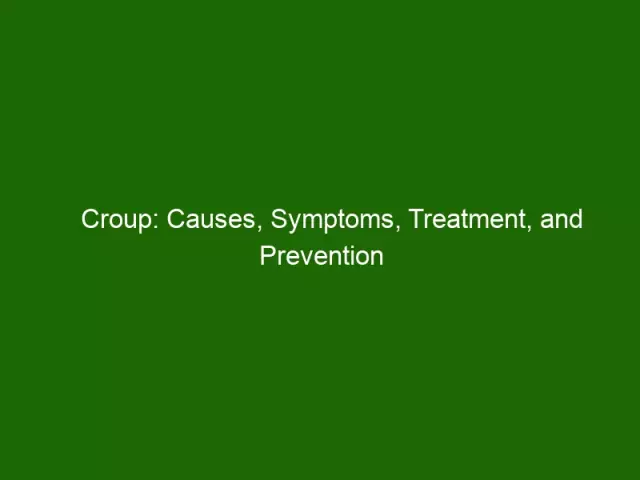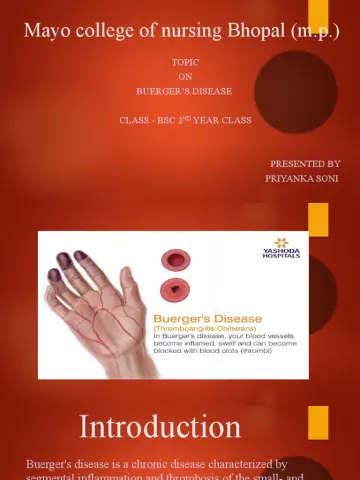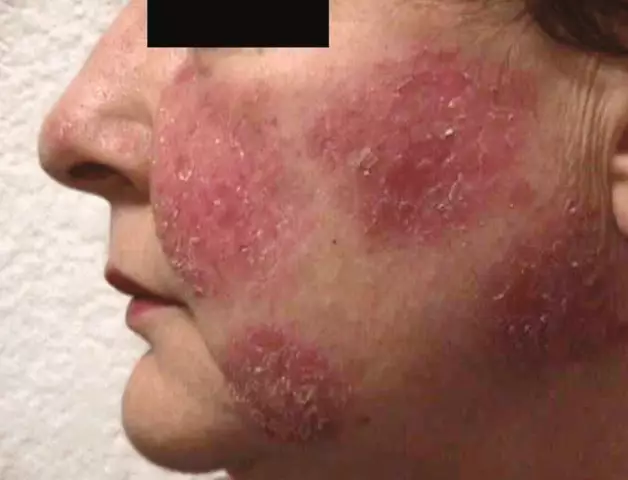- Author Rachel Wainwright [email protected].
- Public 2023-12-15 07:39.
- Last modified 2025-11-02 20:14.
Croup
One of the most difficult conditions in children in the first years of life is true and false croup. The croup is an acute lining laryngitis. With croup, acute viral respiratory diseases, influenza, diphtheria, measles cause edema and inflammation of the loose fatty tissue located under the vocal folds. Puffiness causes a narrowing of the lumen of the larynx, which is accompanied by difficulty breathing. In severe cases, death from asphyxiation is possible. Croup occurs in children mainly under the age of 5 years. At an older age, changes occur in the anatomical structure of the larynx: loose fiber almost completely disappears. This means that inflammation in this area does not lead to severe edema, and croup is impossible. Most often, croup occurs in weakened children prone to allergic reactions, born prematurely and have suffered birth trauma.
True croup

True croup is now relatively rare due to the declining prevalence of diphtheria. But even in our time, individual cases of the disease are possible. Laryngeal diphtheria can develop on its own or in combination with pharyngeal diphtheria, mainly in young children. It is this state that is considered to be a true croup. In this case, filmy fibrous overlays spread to the mucous membrane of the larynx. In the future, muscle spasm and asphyxia may develop. True croup is difficult and often requires surgery.
False croup
False croup is a rapidly developing edema of the laryngeal mucosa in the lining space. The cause of false croup can be various viral diseases of the upper respiratory tract, influenza, measles, chemical and thermal burns of the larynx. Edema is rarely accompanied by a spasm of the muscles in the larynx. False croup can cause asphyxia only in the most severe cases. Usually, even without treatment, croup resolves within a few hours, although recurrent episodes are possible. The presence of severe fever and shortness of breath is considered unfavorable.
Croup symptoms
Most often, croup occurs in a child at night. As the swelling of the tissue under the vocal folds increases, symptoms of croup appear and intensify. The first signs are not very noticeable. The child can show anxiety, fear, starts to be capricious and cry. Then there is a hacking, dry, as if barking cough. The child develops shortness of breath. Breathing becomes rapid and shallow. There can be up to 30-60 respiratory movements per minute. These symptoms of croup indicate asphyxiation (lack of oxygen) and swelling of the laryngeal mucosa. As the croup progresses, the baby's complexion turns red, then pale or bluish. The skin on the body and limbs can also become bluish. The cough becomes more rough and intrusive. A clearly audible wheezing appears when breathing. Against the background of difficult inhalation, retractions of the intercostal spaces appear. The severe phase of the croup is accompanied by severe asphyxia. The child rushes about, becomes covered with cold sweat, loses consciousness, the pulse becomes arrhythmic, weak. If you do not provide medical assistance, then convulsions and death from suffocation develop further. Symptoms of pseudo-croup rarely correspond to the picture of severe asphyxia. Signs of such croup persist from several hours to a day, and then disappear completely. True croup in diphtheria is characterized by more severe symptoms. In addition, with true diphtheria croup, hoarseness of the voice appears very quickly, and then a complete loss of voice. The child either cannot speak at all, or speaks in a whisper. Symptoms of croup require immediate action. The child rushes about, becomes covered with cold sweat, loses consciousness, the pulse becomes arrhythmic, weak. If you do not provide medical assistance, then convulsions and death from suffocation develop further. Symptoms of pseudo-croup rarely correspond to the picture of severe asphyxia. Signs of such croup persist from several hours to a day, and then completely disappear. True croup in diphtheria is characterized by more severe symptoms. In addition, with true diphtheria croup, hoarseness of the voice appears very quickly, and then a complete loss of voice. The child either cannot speak at all, or speaks in a whisper. Symptoms of croup require immediate action. The child rushes about, becomes covered with cold sweat, loses consciousness, the pulse becomes arrhythmic, weak. If you do not provide medical assistance, then convulsions and death from suffocation develop further. False croup symptoms rarely match those of severe asphyxia. Signs of such croup persist from several hours to a day, and then disappear completely. True croup in diphtheria is characterized by more severe symptoms. In addition, with true diphtheria croup, hoarseness of the voice appears very quickly, and then a complete loss of voice. The child either cannot speak at all, or speaks in a whisper. Symptoms of croup require immediate action. Symptoms of pseudo-croup rarely correspond to the picture of severe asphyxia. Signs of such croup persist from several hours to a day, and then disappear completely. True croup in diphtheria is characterized by more severe symptoms. In addition, with true diphtheria croup, hoarseness of the voice appears very quickly, and then a complete loss of voice. The child either cannot speak at all, or speaks in a whisper. Symptoms of croup require immediate action. Symptoms of pseudo-croup rarely correspond to the picture of severe asphyxia. Signs of such croup persist from several hours to a day, and then completely disappear. True croup in diphtheria is characterized by more severe symptoms. In addition, with true diphtheria croup, hoarseness of the voice appears very quickly, and then a complete loss of voice. The child either cannot speak at all, or speaks in a whisper. Symptoms of croup require immediate action. Symptoms of croup require immediate action. Symptoms of croup require immediate action.
Croup treatment
Croup in children requires compulsory medical attention. Parents should not show their fear to the child, so as not to provoke a sharp deterioration in the condition. In no case should you fight croup yourself. This is one of the most dangerous conditions requiring immediate medical attention. It is necessary to call an ambulance team or a doctor from the clinic. Before the arrival of doctors, it is necessary to provide fresh air to the patient's bed - open a window, a window. The child can be picked up, but it must be held in an upright position. Feet can be placed in a bowl of hot water. Give your baby warm water, tea, or milk. When the doctor arrives, stay judicious, follow all the recommendations clearly. The onset of laryngeal edema will require immediate hospitalization. In no case should you insist on outpatient treatment of croup in children in the first years of life. If the child suffocates, the doctor will have to resort to tracheotomy. This is a small operation, which consists in cutting the trachea and introducing a special cannula (tubule) into the lumen. Such a measure will provide the child with air flow into the lungs, and, therefore, prevent death as a result of asphyxiation. Conservative therapy without surgery is possible at the initial stages of the croup. Therapy for true croup consists in the introduction of anti-diphtheria serum according to the Bezreko method. Serum dose for laryngeal diphtheria is 40,000-50,000 international units. The antibiotics of choice for treating diphtheria are erythromycin or penicillin drugs. The role of antibiotics in the treatment of croup in diphtheria is only auxiliary. False croup is treated with glucocorticosteroids, antihistamines, adrenaline solution. Inhalation of saline (0.9% sodium chloride) is possible. Tracheotomy for false croup is necessary only in 1% of cases. The prognosis of any croup with not too pronounced stenosis of the larynx is favorable. Severe forms requiring surgical treatment are often complicated by pneumonia. The greatest danger to life is purulent croup with necrosis in young children (up to 3 years). The most vulnerable are children with overweight, thymomegaly, and allergic diseases. The prognosis of any croup with not too pronounced stenosis of the larynx is favorable. Severe forms requiring surgical treatment are often complicated by pneumonia. The greatest danger to life is purulent croup with necrosis in young children (up to 3 years). The most vulnerable are children with overweight, thymomegaly, and allergic diseases. The prognosis of any croup with not too pronounced stenosis of the larynx is favorable. Severe forms requiring surgical treatment are often complicated by pneumonia. The greatest danger to life is purulent croup with necrosis in young children (up to 3 years). The most vulnerable are children with overweight, thymomegaly, and allergic diseases.
Prevention of cereals
Prevention of true croup in children is primarily the prevention of diphtheria. The program of preventive vaccinations is working successfully in Russia. The vaccine is first administered to a child at 3 months, and then a series of repeated revaccinations is performed for children and adults. It is necessary to repeat the vaccinations because gradually the artificial immunity to diphtheria fades away.

For the prevention of croup, the main role is played by the prevention of influenza and all acute viral respiratory infections. It is especially important to protect the child during seasonal epidemics. Sick adults and other children should be isolated. The hardening of children, interferon preparations, breathing exercises are of some importance. Remembering that obese children are more prone to croup, pay attention to the child's weight from an early age. Check with your pediatrician to determine if your child's weight is appropriate for age and height. If excess weight is detected, it is necessary to actively begin the fight against excess pounds. Exercise and proper nutrition will help your child grow up active and healthy.
YouTube video related to the article:
The information is generalized and provided for informational purposes only. At the first sign of illness, see your doctor. Self-medication is hazardous to health!






